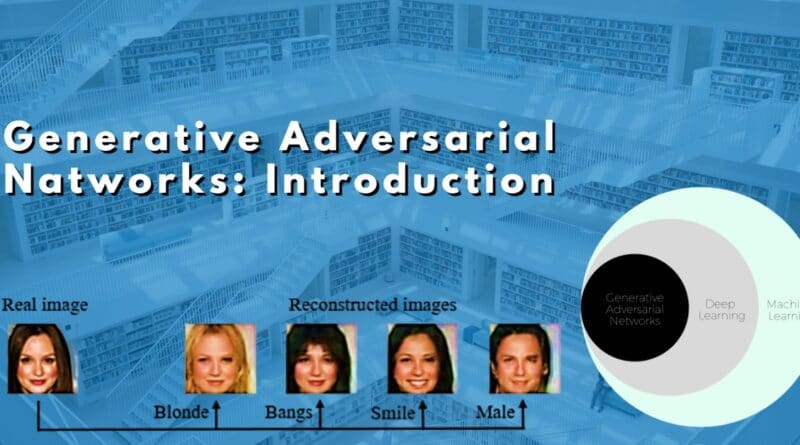Generative Adversarial Networks(GAN’s): Introduction & Outlook
Abstract
Generative Adversarial Networks, or GANs for short, are a method to generative modeling using deep learning approach Unsupervised learning, such as convolutional neural networks. Recently, generative adversarial networks (GAN) have become one of the foremost popular topics in the artificial intelligence field. Its outstanding ability to generate realistic samples. Encourage by a two-player zero-sum game, GANs consist of a generator and a discriminator both trained under the adversarial learning approach. The goal of GANs is to judge the distribution of real data samples and generate new samples from scratch from that distribution. Since their initiation, GANs have been widely studied due to their massive perspective for applications, including image and vision computing, speech and language processing, etc. In this review paper, I try to summarize the GAN and its applications.
Introduction
Generative adversarial networks, or (G A Ns), are a very powerful type of neural network used for the unsupervised machine learning process. Made up of two rival(competing) models which run in competition with one another, GANs are capable to capture and copy difference within a dataset. They are excellent for image generation and manipulation, but they can also be deployed for tasks like understanding the risk of security and recovery in healthcare and pharmacology. Design by Ian Goodfellow with his partners in 2014. Two neural networks fight with each other in a game to win (just like game theory).
How do Generative Adversarial Networks work?
Let’s start with a simple analogy(likeness). You have a painting – say the Mona Lisa – and we have a master forger who wants to create a duplicate painting. The forger does this by learning
how the original painter – Leonardo Da Vinci – produced the painting.
Meanwhile, you have an investigator trying to capture the forger and ‘second guess’ the rules the forger is learning.
The forger is that the generator network used to map this onto the architecture of a GAN, which learns the distribution of classes while the investigator is the discriminator network, which learning the boundaries between those classifications – the formal ‘shape’ of the dataset.
1)Using GANs for Security
The rise of AI has been wonderful for many industries. But there’s a true concern that has shadowed the whole AI revolution – cyber threats. Even deep neural networks are vulnerable to being hacked. A constant concern of industrial applications is that they should be strong against cyber-attacks. There’s a lot of confidential information on the line! GANs are proving to be of vast(massive) help here, directly addressing the concern of “adversarial attacks”. These adversarial attacks use a variety of techniques to fool deep learning architectures. GANs are used to make existing deep learning models tougher to these techniques. How? By creating more such fake examples and training the model to recognize them. Pretty clever stuff. One of the examples is the Google brain project.
Google brain project
One of the best examples of GAN is a google brain project back in 2016 – researchers used it develops a method of encryption.
This process used 3 neural networks – Alice, Bob, and Eve. Alice’s job is to send an encrypted message to Bob. Bob’s job is to decode that message, while Eve’s job is to intercept it.
To begin with, Alice’s messages were easily intercepted by Eve. However, due to Eve’s adversarial work, Alice began to develop its own encryption strategy – it takes 15,000 runs for Alice to successfully encrypt a message that could be decode by Bob that Eve couldn’t intercept.
2)GANs In Medical
GANs are also being used in fields such as drug Structure research providing awesome results day by day. The neural networks can be trained on the existing drugs Structures and suggest new synthetic chemical structures that improve on drugs that exist already.
3)GANs for Image editing
Most image editing software these days don’t give us much freedom to make creative changes in pictures. For example, let’s say you want to change the appearance of a 90-year-individual by changing his / her hairstyle. This can’t be done by the current image editing software out there. But guess what? Using GANs, we can reconstruct images and attempt to change the appearance easily and drastically with many features. [1] out there.
4)GANs for 3D Object Generation
It won’t surprise you understanding GANs are quite popular within the gaming industry rise drastically. Game designers work countless hours recreating 3D avatars and backgrounds
to give them a realistic feel. And let me assure you, it certainly takes a lot of effort to form 3D models by imagination. Does this sound unrealistic?. You might believe the incredible power of GANs, wherein they can be used to automate the entire process easily!
I suggest you watch this video >https://raw.githubusercontent.com/maxorange/pix2vox/master/img/sample.gif
In the end, Remember
As we have noticed, GANs offer some really outstanding exciting opportunities in AI.
There are two key benefits you need to remember about it: GANs solve the complication of generating data when you don’t have enough data to begin with & second, they require no human supervision (Unsupervised learning).
Extra Overview
In this paper, we saw the state of the art of GANs. Since the proposal of GAN in 2014 by lan Goodfellow has become a research focus of AI. The core idea of GANs is taken from two-player zero-sum games in game theory. A GAN usually comprises a generator and a discriminator. The ability to generate “infinite” new samples from distribution has excellent application value in numerous fields such as image and vision computing, language processing and speech, and information security. GANs are comparatively new and still require some research to reach their new potential. Researchers should struggle to develop better theoretical understanding and improve training algorithms for this framework. The success of GANs on this front would improve many other applications. GANs are crucial and have the potential to produce many other applications in the future.
Hand on Experience
IBM GAN demonstration
3D sketch-modeling demonstration


References
GAN’s: Introduction and Outlook by Kunfeng Wang, Member, IEEE, Chao Gou, Yanjie Duan, Yilun Lin, Xinhu Zheng,
and Fei-Yue Wang.
https://www.researchgate.net/publication/320827528_Generative_Adversarial_Networks_Introduction_and_Outlook (Research paper link)
Invertible Conditional GANs for image editing by Guim Perarnau, Joost van de Weijer, Bogdan Raducanu, Jose M. Álvarez
https://arxiv.org/pdf/1611.06355.pdf (Research paper link)
Image-to-Image Translation with Conditional Adversarial Networks by Phillip Isola,Jun-Yan Zhu,Tinghui Zhou, Alexei A. Efros
https://arxiv.org/pdf/1611.07004v3.pdf (Research paper link)
other helpful sites
https://www.analyticsvidhya.com/
All Papers Available on the Below Link



